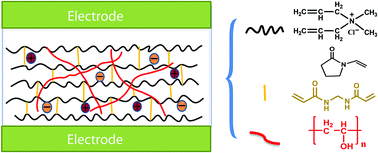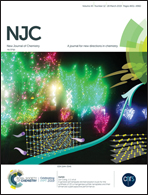Dielectric and transport properties of cationic polyelectrolyte membrane P(NVP-co-DMDAAC)/PVA for solid-state supercapacitors†
Abstract
Polyelectrolytes with good ionic conductivity and dielectric properties have been shown to be superior for supercapacitors and other power storage devices. Here, a cationic polyelectrolyte with blended poly(N-vinylpyrrolidone-co-diallyl dimethyl ammonium chloride) (P(NVP-co-DMDAAC)) copolymer and poly(vinyl alcohol) (PVA) was prepared via the interpenetrating polymer network (IPN) technique. The dielectric properties, ionic conductivity, mechanical properties and the influence of the thicknesses of hydrogel membranes on capacitance properties were studied. The introduction of the cationic DMDAAC monomer and polar PVA increased the integrated performance of the PNVP hydrogel. In comparison with PVA, PNVP, and P(NVP-co-DMDAAC), P(NVP-co-DMDAAC)/PVA IPN hydrogel exhibited higher permittivity of 27.19 at 1 kHz frequency and the maximum ionic conductivity of 3.66 × 10−2 S cm−1 at 10% PVA dosage. The tensile strength increased with the increase in the PVA content. The specific capacitances of P(NVP-co-DMDAAC)/10PVA increased with the decrease in the thickness of the hydrogel membrane and its retention rate was 95% after 1000 cycles.


 Please wait while we load your content...
Please wait while we load your content...